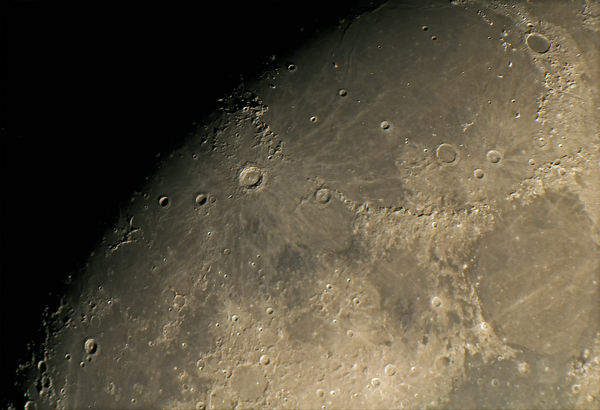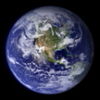A little closer to the moon
Mar 1, 2015 21:15:44 #
northcoast42
Loc: Puget Sound, Washington
I captured this through my telescope with the aid of a 4X Powermate and Canon 60D in late January. The detailed crater in the upper center left with the three mounds in it is Copernicus. It's about 93 kilometers across. Directly right, almost in the very center of the image is a somewhat fuzzy looking crater called Eratosthenes. It's about 58 km across and marks the beginning of the Apennine mountains. If you trace up the range to just prior to the open smooth area where the Apennines end, you'll see a sort of narrow box canyon opening to the north. That's where Apollo 15 landed back in 1971. The three craters directly above that are, from left to right, Archimedes (83km), Autolycus (39km) and Aristillus (55km). Finally, the very circular crater at the top right is Plato (101km). Every single crater, no matter how small, has a name! The mountains around that crater are the Alpes! The moon has Alpes...hmmm...
Mar 1, 2015 21:22:18 #
Mar 1, 2015 21:30:09 #
Very cool, great photo.
Thanks for the tour and info, all very interesting :thumbup:
Thanks for the tour and info, all very interesting :thumbup:
Mar 2, 2015 06:47:54 #
Mar 2, 2015 12:24:55 #
I like to use Copernicus as my focal point. Even when the viewing is bad, this is a great crater to focus on.
Nice shot and nice prod. :thumbup:
Nice shot and nice prod. :thumbup:
Mar 3, 2015 15:52:07 #
Thank you very much John for the lesson that goes along with this wonderful shot.
And congrats in being able to get such a clear shot with all that 4x magnification.
And congrats in being able to get such a clear shot with all that 4x magnification.
Mar 3, 2015 22:10:36 #
Mar 18, 2015 01:14:42 #
northcoast42
Loc: Puget Sound, Washington
St3v3M wrote:
Beautiful. Thank you for sharing. S-
Glad you enjoyed the image St3v3M. Thanks for looking in and commenting. I appreciate it.
Mar 18, 2015 01:15:35 #
northcoast42
Loc: Puget Sound, Washington
BassmanBruce wrote:
Very cool, great photo.
Thanks for the tour and info, all very interesting :thumbup:
Thanks for the tour and info, all very interesting :thumbup:
Thanks Bruce. Glad you liked it. I appreciate your comments.
Mar 18, 2015 01:18:29 #
Another nice shot... single or stacked image... what type and size telescope? Does the 4x Powermate do a good job... 1-1/4" or 2"??
northcoast42 wrote:
I captured this through my telescope with the aid ... (show quote)
Mar 18, 2015 01:18:40 #
northcoast42
Loc: Puget Sound, Washington
Albuqshutterbug wrote:
I like to use Copernicus as my focal point. Even when the viewing is bad, this is a great crater to focus on.
Nice shot and nice prod. :thumbup:
Nice shot and nice prod. :thumbup:
Thanks Albuqshutterbug. Copernicus is a favorite of mine also. It's good when it's offset just a bit into the shadows. The moon was waxing gibbous that night so the imaging was pretty good.
Mar 18, 2015 01:23:47 #
northcoast42
Loc: Puget Sound, Washington
CraigFair wrote:
Thank you very much John for the lesson that goes along with this wonderful shot.
And congrats in being able to get such a clear shot with all that 4x magnification.
And congrats in being able to get such a clear shot with all that 4x magnification.
Thanks Craig. I appreciate your comments very much and I'm glad you enjoyed the image. This wasn't a single image. I actually stacked about 120 images to pull the sharpness and detail out without the noise, although even a single image wasn't bad on the night I took this.
Mar 18, 2015 01:31:39 #
northcoast42
Loc: Puget Sound, Washington
brucew29 wrote:
Another nice shot... single or stacked image... what type and size telescope? Does the 4x Powermate do a good job... 1-1/4" or 2"??
Thanks Bruce. I stacked about 120 images to get the detail without the noise. I used my Canon 60D attached to my 127mm Explore Scientific refractor. I really like the 4x Powermate (2") and have no problem recommending it. I've gotten some pretty nice images of the moon and planets (Jupiter, Mars and Saturn so far) with it. My 127 only has a 952mm focal length so the 4x works well with it. I'm waiting on Saturn and Mars to climb back into the sky for another shot at them.
Mar 18, 2015 01:33:10 #
northcoast42
Loc: Puget Sound, Washington
SonnyE wrote:
Beautiful! And very informative. Thank You.
Thank you Sonny. Always appreciate your viewing and comments. Glad you enjoyed the image.
If you want to reply, then register here. Registration is free and your account is created instantly, so you can post right away.






